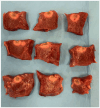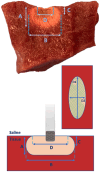Comparative Study of Lesions Obtained through Radiofrequency between the Irrigated Ablation Catheter with a Flexible Tip and the Non-Irrigated Catheter in Ex Vivo Porcine Hearts
- PMID: 38392350
- PMCID: PMC10886553
- DOI: 10.3390/biology13020132
Comparative Study of Lesions Obtained through Radiofrequency between the Irrigated Ablation Catheter with a Flexible Tip and the Non-Irrigated Catheter in Ex Vivo Porcine Hearts
Abstract
Background: At the same conditions of delivered power and contact force, open-irrigated radiofrequency ablation catheters are believed to create deeper lesions, while non-irrigated ones produce shallower lesions. This ex vivo study aims to directly compare the lesion dimensions and characteristics of an irrigated ablation catheter with a flexible tip and a non-irrigated solid-tip catheter.
Methods: Radiofrequency lesions were induced on porcine myocardial slabs using both open-tip irrigated and non-irrigated standard 4 mm catheters at three power settings (20 W, 30 W, and 40 W), maintaining a fixed contact force of 10 gr. A lesion assessment was conducted including the lesion depth, depth at the maximum diameter, and lesion surface diameters, with the subsequent calculation of the lesion volume and area being undertaken.
Results: Irrigated catheters produced lesions with significantly higher superficial widths at all power levels (3.8 vs. 4.4 mm at 20 W; 3.9 mm vs. 4.4 mm at 30 W; 3.8 mm vs. 4.5 mm at 40 W; p = 0.001, p = 0.019, p = 0.003, respectively). Non-irrigated catheters resulted in significantly higher superficial areas at all power levels (23 mm2 vs. 18 mm2 at 20 W; 25 mm2 vs. 19 mm2 at 30 W; 26 mm2 vs. 19 mm2 at 40 W; p = 0.001, p = 0.005, p = 0.001, respectively). Irrigated catheters showed significantly higher values of lesion maximum depth at 40 W (4.6 mm vs. 5.5 mm; p = 0.007), while non-irrigated catheters had a significantly higher calculated volume at 20 W (202 µL vs. 134 µL; p = 0.002).
Conclusions: Radiofrequency ablation using an irrigated catheter with a flexible tip has the potential to generate smaller superficial lesion areas compared with those obtained using a non-irrigated catheter.
Keywords: ablation; arrhythmia; irrigated catheter; lesion characteristics; radiofrequency.
Conflict of interest statement
The authors declare no conflicts of interest.
Figures





Similar articles
-
Radiofrequency catheter ablation: different cooled and noncooled electrode systems induce specific lesion geometries and adverse effects profiles.Pacing Clin Electrophysiol. 2003 Jul;26(7 Pt 1):1438-45. doi: 10.1046/j.1460-9592.2003.t01-1-00208.x. Pacing Clin Electrophysiol. 2003. PMID: 12914619
-
Effect of Irrigant Characteristics on Lesion Formation After Radiofrequency Energy Delivery Using Ablation Catheters with Actively Cooled Tips.J Cardiovasc Electrophysiol. 2015 Jul;26(7):792-8. doi: 10.1111/jce.12682. J Cardiovasc Electrophysiol. 2015. PMID: 25864402
-
Effects of open-irrigated radiofrequency ablation catheter design on lesion formation and complications: in vitro comparison of 6 different devices.J Cardiovasc Electrophysiol. 2013 Oct;24(10):1157-62. doi: 10.1111/jce.12175. Epub 2013 May 29. J Cardiovasc Electrophysiol. 2013. PMID: 23718822
-
Characteristics of In Vivo Lesion Formation With a Temperature-Controlled Diamond-Tip Radiofrequency Ablation Catheter in the Ventricle: A Preclinical Model.Circ Arrhythm Electrophysiol. 2025 Feb;18(2):e013120. doi: 10.1161/CIRCEP.124.013120. Epub 2025 Jan 24. Circ Arrhythm Electrophysiol. 2025. PMID: 39851050
-
Radiofrequency ablation using a novel insulated-tip ablation catheter can create uniform lesions comparable in size to conventional irrigated ablation catheters while using a fraction of the energy and irrigation.J Cardiovasc Electrophysiol. 2022 Jun;33(6):1146-1156. doi: 10.1111/jce.15461. Epub 2022 Apr 12. J Cardiovasc Electrophysiol. 2022. PMID: 35322477 Free PMC article.
Cited by
-
Impact of irrigation flow rates on lesion size and safety of ablation catheters: an ex vivo porcine heart study.Heart Vessels. 2025 May;40(5):446-455. doi: 10.1007/s00380-024-02475-6. Epub 2024 Oct 22. Heart Vessels. 2025. PMID: 39438335
References
-
- Leshem E., Zilberman I., Barkagan M., Shapira-Daniels A., Sroubek J., Govari A., Buxton A.E., Anter E. Temperature-Controlled Radiofrequency Ablation Using Irrigated Catheters: Maximizing Ventricular Lesion Dimensions While Reducing Steam-Pop Formation. JACC Clin. Electrophysiol. 2020;6:83–93. doi: 10.1016/j.jacep.2019.08.015. - DOI - PubMed
-
- Malagù M., Vitali F., Marchini F., Fiorio A., Sirugo P., Mele D., Brieda A., Balla C., Bertini M. Ablation of Atrioventricular Nodal Re-Entrant Tachycardia Combining Irrigated Flexible-Tip Catheters and Three-Dimensional Electroanatomic Mapping: Long-Term Outcomes. J. Cardiovasc. Dev. Dis. 2021;8:61. doi: 10.3390/jcdd8060061. - DOI - PMC - PubMed
LinkOut - more resources
Full Text Sources

